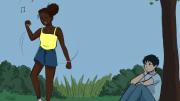A man’s beard is drawn as a mass of tendrils, transforming into feathers as he gazes stoically into the distance, in the piece “Untitled No. 1.” In this surreal fashion, and with tremendous attention to detail, local artist and University of Manitoba school of art graduate Ted Barker has created 11 pencil works for his exhibit tucked away in the narrow hallway that is Semai Gallery.
This exhibit, entitled New World Aristocracy, explores the relationship between European leaders and the land they conquered. In each of these works a historicized male figure is depicted in a proud posture, set against a white backdrop. Some of the works are portraits, while others are full figures. Like the male figure whose beard grows into feathers in “Untitled No. 1,” each drawing has a whimsical element to it. In “Untitled No. 9” a man is seated in a wooden chair holding a baby deer in his lap; the way this image is constructed makes it unclear whether the small animal is about to jump off of the man, or whether it is content. Either way, this unnatural paring and the precarious situation has been recorded with great skill and technique. Moreover, these drawings were created as a definite series, with a consistent style. From the clean picture frames, to the tremendous amount of detail, it is clear that Barker has carefully considered each element of his craftsmanship.
The drawings are often engaging and playful, like “Untitled No. 8,” which shows a man who has a turkey’s rear end as a head, or “Untitled No. 6,” which shows a man seated with small birds perched on various parts of his body, some with beaks open in mid-chirp. These surreal pairings continue throughout the exhibit, and some of the well-dressed men have fur covering their entire faces and heads. By juxtaposing the male figures with elements such as feathers, animals and furs, Barker said he is commenting on the identity struggle that happens when two cultures meet.
Barker explained, these works are a comment on the “desire to make sense of one’s identity and the identity of one’s home.” This includes Barker’s personal struggle with claiming Canada as his own home. He explained, “Canada’s colonial history isn’t one that I’m proud of. Even though I had nothing to do with that past and it happened hundreds of years ago, I feel a guilt. That’s a strange feeling and it has a lot to do with being unsure about calling this place ‘home.’”
When Barker started to make these drawings he was doing so intuitively, without understanding what they meant to him nor why he found them intriguing. “The more I worked on them, I realized that I was trying to create historical images that would explain the duality that I felt about Canada’s culture. I was trying to force together two elements that didn’t fit and yet are what this country is based upon,” he said.
Through these images Barker represents the identity struggles that come from colonization and cultural appropriation. But rather than use his art as a way of commenting on whether he thinks Canada’s colonial past is “right” or “wrong,” Barker is trying to create a starting point for discussion.
“I’m presenting the images that formed from one point of realization in an ongoing process. History is entirely subjective and basically only exists in memory. Making specific comments about it, I think, limits peoples interpretation,” the artist said.
Barker uses his carefully crafted drawings, not as a platform for his own opinion, but “to stimulate viewers to think about their own.” In New World Aristocracy, it is Barker’s intention that, “the images speak on a relatable level about our country’s past [and] spark a consideration of one’s own place in that history.”
New World Aristocracy runs until Dec. 17 at Semai Gallery.



